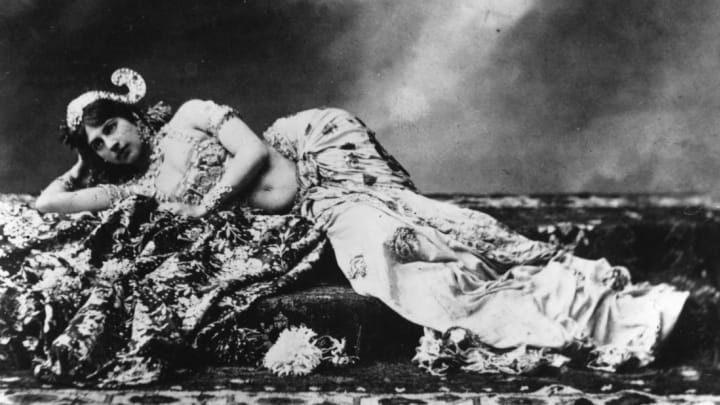Nearly everyone has heard of Mata Hari, one of the most cunning and seductive spies of all time. Except that statement isn't entirely true. Cunning and seductive, yes. Spy? Probably not.
Margaretha Geertruida Zelle was the eldest daughter of a hat store owner who was quite wealthy thanks to some savvy oil investments. When her mother died, her father remarried and shuffled his children off to various relatives. To escape, an 18-year-old Margaretha answered an ad in the paper that might have read something like this: "Dutch Colonial Army Captain Seeks Wife. Compatibility not important. Must not mind blatant infidelity or occasional beatings."
She had two children with Captain Rudolf MacLeod, but they did nothing to improve the marriage. He brazenly kept a mistress and a concubine; she moved in with another officer. Again, probably looking to escape her miserable existence, Margaretha spent her time in Java (where the family had relocated for Captain MacLeod's job) becoming part of the culture, learning all about the dance and even earning a dance name bestowed upon her by the locals—"Mata Hari," which meant "eye of the day" or "sun."
Her son died after being poisoned by an angry servant (so the MacLeods believed).
Margaretha divorced her husband, lost custody of her daughter and moved to Paris to start a new life for herself in 1903. Calling upon the dance skills she had learned in Java, the newly restyled Mata Hari became a performer, starting with the circus and eventually working her way up to exotic dancer.
To make herself seem more mysterious and interesting, Mata Hari told people her mother was a Javanese princess who taught her everything she knew about the sacred religious dances she performed. The dances were almost entirely in the nude.
Thanks to her mostly-nude dancing and tantalizing background story, she was a hot commodity all over Europe. During WWI, this caught the attention of British Intelligence, who brought her in and demanded to know why she was constantly traipsing across the continent. Under interrogation, she apparently told them she was a spy for France—that she used her job as an exotic dancer to coerce German officers to give her information, which she then supplied back to French spymaster Georges Ladoux. No one could verify these claims and Mata Hari was released.
Not too long afterward, French intelligence intercepted messages that mentioned H-21, a spy who was performing remarkably well. Something in the messages reminded the French officers of Mata Hari's tale and they arrested her at her hotel in Paris on February 13, 1917, under suspicion of being a double agent.
Mata Hari repeatedly denied all involvement in any spying for either side. Her captors didn't believe her story, and perhaps wanting to make an example of her, sentenced her to death by firing squad. She was shot to death 100 years ago today, on October 15, 1917.
In 1985, one of her biographers convinced the French government to open their files on Mata Hari. He says the files contained not one shred of evidence that she was spying for anyone, let alone the enemy. Whether the story she originally told British intelligence was made up by them or by her to further her sophisticated and exotic background is anyone's guess.
Or maybe she really was the ultimate spy and simply left no evidence in her wake.
